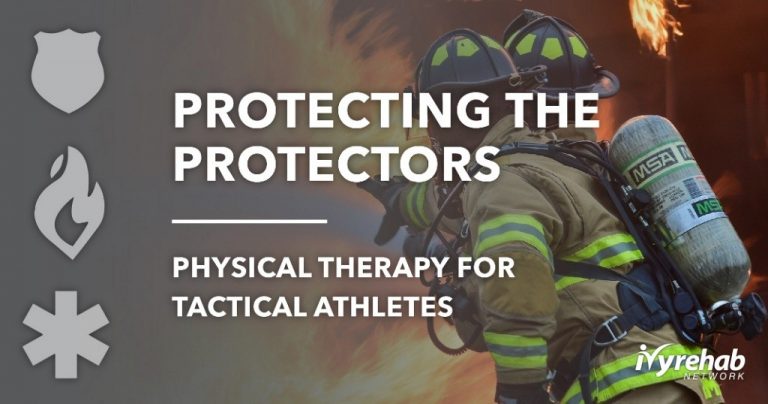
Protecting the Protectors – PT for Tactical Athletes
There are a lot of physical fitness requirements needed in law enforcement, the military, and other emergency rescue professions. Sometimes called the “tactical athlete,” these individuals routinely perform physically demanding and athletic tasks on the job. Power, strength, aerobic conditioning, agility, balance, and mental and physical stamina are necessary to serve, protect and save people’s lives.
Police officers have to be ready to chase down or tackle a suspect. Firefighters must climb ladders and knock down doors to fight a fire. EMTs are called on to extract passengers after an auto accident and respond to life and death situations. Military personnel are trained to be on high alert for everything and anything. Not only do these occupations demand unique physical and mental training strategies, but they often require wearing protective clothing and lugging around heavy equipment.
On the flip side, when first responders aren’t responding to an emergency, they are often sedentary. It can be a recipe for injury, heart attack or chronic pain. Cardiovascular disease is the leading cause of line-of-duty deaths for firefighters. If you perform physically demanding athletic tasks on the job, physical therapy can help you optimize your performance. It can also reduce the risk of injury or speed up recovery in the event of an injury.
Preparing for Job Demands of Tactical Athletes
Working with a physical therapist can help first responders and military personnel understand the importance of taking care of themselves. Regular exercise, sleep, stress management, and nutrition all play a role in staying fit on and off duty. Helping them see that they are at high risk for injury, especially jumping into high-stress, high-intensity activity after being sedentary, is the first step. PTs can conduct a musculoskeletal evaluation to identify any weaknesses or imbalances, factoring in the unique physical demands of your job. If you’re returning to work after surgery or injury, they will work with you to design a therapeutic exercise program tailored to rehabbing an injury. PTs trained in sports, occupational and orthopedic medicine can help you prevent injury, improve occupational performance, and optimize your biomechanical and physiological responses.
“The job of a law enforcement officer requires physicality, but the logistics are counterproductive to that. An officer on patrol typically spends 50% of his or her time sitting in a vehicle,” according to Kyle Sela, PT, DPT.
Internalizing the Athlete Role
The donut-eating police officer, the firefighter who manhandles heavy firehose, and even the veteran National Guardsman doesn’t always see themselves as athletes. PTs can help these tactical athletes understand the importance of staying physically fit.
“Peak performance requires a smart, disciplined approach to maintaining body and mind,” according to Danny McMillian, PT, DSc, a former Army PT and current clinical professor at the University of Puget Sound.
Treating Overuse Injuries in the Tactical Athlete
First responders require specific and unique rehabilitation interventions to optimize on-the-job performance and reduce the risk of injury. Tactical athletes are prone to the same common injuries that befall traditional athletes. PTs can help treat, prehab and rehab overuse injuries, sprains and strains, or pain in the back, neck, shoulders, and lower extremities. They can prescribe corrective exercises to help prevent or mitigate those injuries, and offer guidance on proper positioning and lifting techniques depending on one’s job duties.
Focusing on the Whole Person
Many first responders and military personnel have to play the role of “tough guy or gal.” It’s hard for them to ask for help or admit they need to make their health a higher priority. The job can be demanding, stressful and include odd shifts and hours, leading to burnout, substance abuse, and depression. The pressure to perform, respond to dangerous situations, deal with post-traumatic stress, and pass the annual fitness test also take a toll on mind, body, and spirit. PTs focus on total-body wellness and can offer advice or referrals for counseling, nutrition, and regular exercise routines. They can develop specific tactical strength and conditioning programs to improve fitness, agility and reaction time for tactical athletes.
“The bodybuilder approach really doesn’t prepare a law enforcement officer to tackle and apprehend a suspect — to truly be a tactical athlete. Education,” Sela says, “can go a long way in getting these individuals into a fitness program that will help them in the long term.”
Alternative therapies including dry needling and soft tissue mobilization can be beneficial in treating pain for those who are short on time. In general, physical therapy can help with injury prevention and enhance a tactical athlete’s overall job performance and quality of life.
That’s a win-win for everyone.
We are Here for Tactical Athletes
Ivy Rehab Network clinics across the country are proud to support first responders and military. If you are dealing with a nagging injury, chronic pain or want to get back to your peak performance, contact a local clinic and see how we can help.
The medical information contained herein is provided as an information resource only, and does not substitute professional medical advice or consultation with healthcare professionals. This information is not intended to be patient education, does not create any patient-provider relationship, and should not be used as a substitute for professional diagnosis, treatment or medical advice. Please consult with your healthcare provider before making any healthcare decisions or for guidance about a specific medical condition. If you think you have a medical emergency, call your doctor or 911 immediately. IvyRehab Network, Inc. disclaims any and all responsibility, and shall have no liability, for any damages, loss, injury or liability whatsoever suffered as a result of your reliance on the information contained herein.